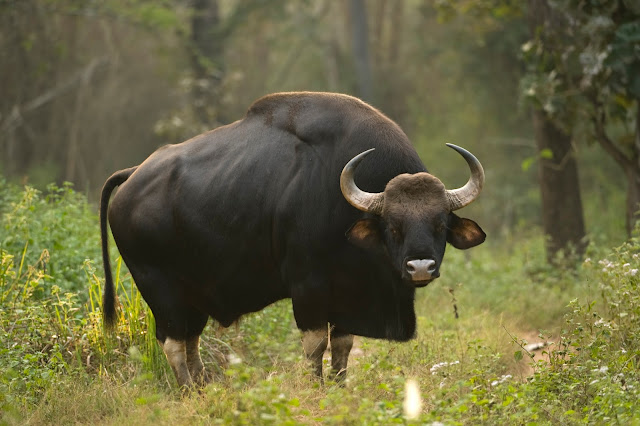The Heaven Of Wild - Western Ghats Part-1
In the World, the most beautiful and amazing thing is "Our Nature"
Nature always balance itself and make things beautiful.
If you people are thinking to visit India and wanting to see Indian wildlife and nature beauty then you must visit "The Heaven Of Wild - The Western Ghats"
Introduction
- The Western Ghats, is a mountain rang that runs along the western side of India.
- The Ghats are older than the Himalayas.
- It runs about 1600 km, North to South along the western edge of the Deccan Plateau.
- It is one of the hottest hotspots of biological diversity in the world.
- In 2006, India applied to the UNESCO MAB for the Western Ghats to be listed as a protected "World Heritage Site". In 2012, the following places are declared as World Heritage Sites.
- Indira Gandhi Wild life Sanctuary and National Park.
- Kalakkad Mundanthurai Tiger reserve.
- Mudumalai National Park.
- Mudumalai Tiger reserve.
- Shendurney Wildlife Sanctuary.
- Neyyar Wildlife Sanctuary.
- Peppara Wildlife Sanctuary.
- Periyar Tiger reserve.
- Srivilliputtur Wildlife Sanctuary.
- Eravikulam National Park.
- Grass Hills National Park.
- Karian Shola National Park.
- Sathyamangalam Wildlife Sanctuary.
- Chinnar Wildlife Sanctuary.
- Silent Valley National Park.
- New Amarambalam Reserve Forest.
- Mukurthi National Park.
- Pushpagiri Wildlife Sanctuary.
- Brahmgiri Wildlife Sanctuary.
- Talakaveri Wildlife Sanctuary.
- Aralam Wildlife Sanctuary
- Kudremukh National Park
- Someshwara Wildlife Sanctuary
- Kaas Plateau
- Koyna Wildlife Sanctuary
- Chandoli National Park
- Radhanagari Wildlife Sanctuary
Peaks
- Western Ghats has many peaks that rise above 2,000 m with Anamudi with height of 2,695 m (8,842 ft.) being the highest peak.
Wild Life of Western Ghats
- This area has over 7,402 flowering plants, 1,814 species of non-flowering plants, 139 mammals species, 508 bird species, 179 amphibian species, 6,000 insect species and 290 fresh water fish species.
- It is likely that many undiscovered species live in the Western Ghats.
- At least 325 globally threatened species occur in the Western Ghats.
Mammals
- There are at least 139 mammal species, of the 16 endemic mammals, 13 are threatened and amongst the 32 threatened species include the critically endangered Malabar large spotted civet (see my previous article "Large spotted Civet"), the endangered lion-tailed macaque, Nilgiri Tahr, Bengal Tiger and Indian elephants (See all my previous articles for more detail about these endangered species), the vulnerable Indian leopard, Nilgiri langur and gaur.
Reptiles
- The major population of snake family Uropeltidae of the reptile class is restricted to this region.
- The region has significant population of vulnerable Mugger Crocodile.
States and Union Territories under Western Ghats
- Western Ghats are spread in six states viz. Gujarat, Maharashtra, Goa, Karnataka, Tamil Nadu, Kerala and two Union Territories viz. Dadra and Nagar Haveli and Pondicherry.
- The range starts near the border of Gujarat south of tapi river where foothills of the ranges are occupying the eastern portion of Dadra and Silvassa in D&N. It ends at its southern part at Anamudi peak in Kerala.
Climate
- In comparison to eastern side, the western side of the Western Ghats is area of high rainfall because the mountains intercept the rain-bearing westerly monsoon winds.
- The dense forests also contribute to high orographic precipitation. The climate is humid and tropical in the lower reaches tempered by the proximity to the sea.
- Elevations of 1,500 m and above in the north and 2,000 m and above in the south have a more temperate climate. Average annual temperature here is around 15 °C.
- In some parts frost is common, and temperatures touch the freezing point during the winter months. Mean temperature range from 20 °C in the south to 24 °C in the north.
- It has also been observed that the coldest periods in the south Western Ghats coincide with the wettest.
- During the monsoon season between June and September, the unbroken Western Ghats chain acts as a barrier to the moisture laden clouds.
- The heavy, eastward-moving rain-bearing clouds are forced to rise and in the process deposit most of their rain on the windward side. Rainfall in this region averages 3,000–4,000 mm. The eastern region of the Western Ghats which lie in the rain shadow, receive far less rainfall averaging about 1,000 mm bringing the average rainfall figure to 2,500 mm
Wild Life Conservation
- The largest population of Asian elephants in the world still roams free across South-western India.
-
This region is also home to 10% of the world's tiger, making it an important area for the long term conservation of this endangered species.






Comments
Post a Comment